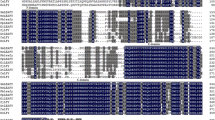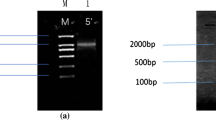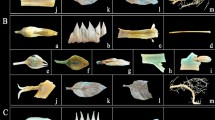Abstract
The LEAFY/FLORICAULA (LFY/FLO) homologous genes are necessary for normal flower development in diverse angiosperm species. To understand the genetic and molecular mechanisms underlying floral initiation and development in Platanaceae, an early divergent eudicot family consisting of large monoecious trees, we isolated a homolog of LFY/FLO, PlacLFY, and its promoter from London plane (Platanus acerifolia). PlacLFY is 1,419 bp in length, with an ORF of 1,122 bp encoding a predicted polypeptide of 374 amino acids and 5′/3′-UTR of 54 and 213 bp, respectively. The putative PlacLFY protein showed a high degree of identity (56–84 %) with LFY/FLO homologs from other species, including two highly conserved regions, the N and C domains, and a less conserved amino-terminal proline-rich region. Real-time PCR analysis showed that PlacLFY was expressed mainly in male inflorescences from May of the first year to March of next year, with the highest expression level in December, and in female inflorescences from June to April of next year. PlacLFY mRNA was also detected strongly in subpetiolar buds of December from 4-year-old and adult trees, and slightly in stem of young seedling and young leaf of adult plant. Additionally, we cloned 1,138 bp promoter sequence of PlacLFY and we drove GUS expression in transgenic tobacco by the chimerical pPlacLFY::GUS construction. Histological GUS staining analysis indicated that PlacLFY promoter can drive GUS gene expression in shoot apex, stem, young leaf and petiole, flower stalk, petal tip, and young/semi-mature fruits of transgenic tobacco, which is almost identical to the expression pattern of PlacLFY in London plane. The results revealed that the PlacLFY gene isolated from London plane is expressed not only in reproductive organ but also in vegetative organs. Moreover, this expression pattern is consistent with the expression pattern in tobacco of a GUS reporter gene under the control of the potential promoter region of PlacLFY.







Similar content being viewed by others
References
Ahearn KP, Johnson HA, Weigel D, Wagner DR (2001) NFL1, a Nicotiana tabacum LEAFY-like gene, controls meristem initiation and floral structure. Plant Cell Physiol 42:1130–1139
An XM, Wang DM, Wang ZL, Li B, Bo WH, Cao GL, Zhang ZY (2011) Isolation of a LEAFY homolog from Populus tomentosa: expression of PtLFY in P. tomentosa floral buds and PtLFY-IR-mediated gene silencing in tobacco (Nicotiana tabacum). Plant Cell Rep 30:89–100
Artandi SE, Merrell K, Avitahl N, Wong KK, Calame K (1995) TFE3 contains two activation domains, one acidic and the other proline-rich, that synergistically activate transcription. Nucleic Acids Res 23:3865–3871
Barui A, Banerjee P, Das RK, Basu SK, Dhara S, Chatterjee J (2011) Immunohistochemical evaluation of p63, E-cadherin, collagen I and III expression in lower limb wound healing under honey. Evidence-based Complement Altern Med: eCAM 2011:239864
Besnard G, Tagmount A, Baradat P, Vigouroux A, Berville A (2002) Molecular approach of genetic affinities between wild and ornamental Platanus. Euphytica 126:401–412
Blazquez MA, Weigel D (2000) Integration of floral inductive signals in Arabidopsis. Nature 404:889–892
Blazquez MA, Soowal LN, Lee I, Weigel D (1997) LEAFY expression and flower initiation in Arabidopsis. Development 124:3835–3844
Boes TK (1994) Floral phenology and morphology of black-cottonwood, Populus trchocarpa (Salicaseae). Am J Bot 81(5):562–567
Bomblies K, Wang RL, Ambrose BA, Schmidt RJ, Meeley RB, Doebley J (2003) Duplicate FLORICAULA/LEAFY homologs zfl1 and zfl2 control inflorescence architecture and flower patterning in maize. Development 130:2385–2395
Bremer B, Bremer K, Chase MW, Fay MF, Reveal JL, Soltis DE, Soltis PS, Stevens PF, Anderberg AA, Moore MJ, Olmstead RG, Rudall PJ, Sytsma KJ, Tank DC, Wurdack K, Xiang JQY, Zmarzty S, Grp AP (2009) An update of the angiosperm phylogeny group classification for the orders and families of flowering plants: APG III. Bot J Linn Soc 161:105–121
Carmona MJ, Cubas P, Martinez-Zapater JM (2002) VFL, the grapevine FLORICAULA/LEAFY ortholog, is expressed in meristematic regions independently of their fate. Plant Physiol 130:68–77
Coen ES, Romero JM, Doyle S, Elliott R, Murphy G, Carpenter R (1990) floricaula: a homeotic gene required for flower development in Antirrhinum majus. Cell 63:1311–1322
Colot V, Robert LS, Kavanagh TA, Bevan MW, Thompson RD (1987) Localization of sequences in wheat endosperm protein genes which confer tissue-specific expression in tobacco. EMBO J 6:3559–3564
Cronquist A (1981) An integrated system of classification of flowering plants. Columbia University Press, New York
Dong ZC, Zhao Z, Liu CW, Luo JH, Yang J, Huang WH, Hu XH, Wang TL, Luo D (2005) Floral patterning in Lotus japonicus. Plant Physiol 137:1272–1282
Elo A, Lemmetyinen J, Novak A, Keinonen K, Porali I, Hassinen M, Sopanen T (2007) BpMADS4 has a central role in inflorescence initiation in silver birch (Betula pendula). Physiol Plant 131:149–158
Flachowsky H, Hattasch C, Hofer M, Peil A, Hanke MV (2010) Overexpression of LEAFY in apple leads to a columnar phenotype with shorter internodes. Planta 231:251–263
Gerber H, Seipel K, Georgiev O, Hofferer M, Hug M, Rusconi S, Schaffner W (1994) Transcriptional activation modulated by homopolymeric glutamine and proline stretches. Science 263:808–811
Guindon S, Gascuel O (2003) A simple, fast, and accurate algorithm to estimate large phylogenies by maximum likelihood. Syst Biol 52:696–704
Guo JL, Yang Q (2008) Molecular cloning and expression analysis of a LFY homologous gene from potato. Plant Mol Biol Rep 26:324–334
Helton ES, Zhang J, Chen X (2008) The proline-rich domain in p63 is necessary for the transcriptional and apoptosis-inducing activities of TAp63. Oncogene 27:2843–2850
Hofer J, Turner L, Hellens R, Ambrose M, Matthews P, Michael A, Ellis N (1997) UNIFOLIATA regulates leaf and flower morphogenesis in pea. Curr Biol: CB 7:581–587
Hope IA, Struhl K (1986) Functional dissection of a eukaryotic transcriptional activator protein, GCN4 of yeast. Cell 46:885–894
Horsch RB, Fry JE, Hoffmann NL, Eichholtz D, Rogers SG, Fraley RT (1985) A simple and general method for transferring genes into plants. Science 227:1229–1231
Ikeda-Kawakatsu K, Maekawa M, Izawa T, Itoh J, Nagato Y (2012) ABERRANT PANICLE ORGANIZATION 2/RFL, the rice ortholog of Arabidopsis LEAFY, suppresses the transition from inflorescence meristem to floral meristem through interaction with APO1. Plant J 69:168–180
Irish VF (2010) The flowering of Arabidopsis flower development. Plant J 61:1014–1028
Jefferson RA, Kavanagh TA, Bevan MW (1987) GUS fusions: beta-glucuronidase as a sensitive and versatile gene fusion marker in higher plants. EMBO J 6:3901–3907
Jensen CS, Salchert K, Gao CX, Andersen C, Didion T, Nielsen KK (2004) Floral inhibition in red fescue (Festuca rubra L.) through expression of a heterologous flowering repressor from Lolium. Mol Breed 13:37–48
Kato K, Ohta K, Komata Y, Araki T, Kanahama K, Kanayama Y (2005) Morphological and molecular analyses of the tomato floral mutant leafy inflorescence, a new allele of falsiflora. Plant Sci 169:131–138
Kelly AJ, Bonnlander MB, Meeks-Wagner DR (1995) NFL, the tobacco homolog of FLORICAULA and LEAFY, is transcriptionally expressed in both vegetative and floral meristems. Plant Cell 7:225–234
Kusano K, Kagawa N, Sakaguchi M, Omura T, Waterman MR (2001) Importance of a proline-rich sequence in the amino-terminal region for correct folding of mitochondrial and soluble microbial p450s. J Biochem 129:271–277
Kyozuka J, Konishi S, Nemoto K, Izawa T, Shimamoto K (1998) Down-regulation of RFL, the FLO/LFY homolog of rice, accompanied with panicle branch initiation. Proc Natl Acad Sci USA 95:1979–1982
Lannenpaa M, Hassinen M, Ranki A, Holtta-Vuori M, Lemmetyinen J, Keinonen K, Sopanen T (2005) Prevention of flower development in birch and other plants using a BpFULL1:BARNASE construct. Plant Cell Rep 24:69–78
Lee J, Oh M, Park H, Lee I (2008) SOC1 translocated to the nucleus by interaction with AGL24 directly regulates leafy. Plant J 55:832–843
Lemmetyinen J, Keinonen K, Sopanen T (2004) Prevention of the flowering of a tree, silver birch. Mol Breed 13:243–249
Li Z, Fang F, Liu G, Bao M (2007) Stable Agrobacterium-mediated genetic transformation of London plane tree (Platanus acerifolia Willd.). Plant Cell Rep 26:641–650
Li Z, Liu G, Zhang J, Zhang J, Bao M (2008) Extraction of high-quality tissue-specific RNA from London plane trees (Platanus acerifolia), permitting the construction of a female inflorescence cDNA library. Funct Plant Biol 35:159–165
Li Z, Zhang J, Liu G, Li X, Lu C, Bao M (2012) Phylogenetic and evolutionary analysis of A-, B-, C- and E-class MADS-box genes in the basal eudicot Platanus acerifolia. J Plant Res 125:371–380
Liu ZR, Liu ZC (2008) The second intron of AGAMOUS drives carpel- and stamen-specific expression sufficient to induce complete sterility in Arabidopsis. Plant Cell Rep 27:855–863
Liu YG, Whittier RF (1995) Thermal asymmetric interlaced PCR: automatable amplification and sequencing of insert end fragments from P1 and YAC clones for chromosome walking. Genomics 25:674–681
Ma YP, Fang XH, Chen F, Dai SL (2008) DFL, a FLORICAULA/LEAFY homologue gene from Dendranthema lavandulifolium is expressed both in the vegetative and reproductive tissues. Plant Cell Rep 27:647–654
Mahmood T, Zar T, Naqvi SMS (2008) Multiple pulses improve electroporation efficiency in Agrobacterium tumefaciens. Electron J Biotechnol 11
Molinero-Rosales N, Jamilena M, Zurita S, Gomez P, Capel J, Lozano R (1999) FALSIFLORA, the tomato orthologue of FLORICAULA and LEAFY, controls flowering time and floral meristem identity. Plant J 20:685–693
Mouradov A, Glassick T, Hamdorf B, Murphy L, Fowler B, Marla S, Teasdale RD (1998) NEEDLY, a Pinus radiata ortholog of FLORICAULA/LEAFY genes, expressed in both reproductive and vegetative meristems. Proc Natl Acad Sci USA 95:6537–6542
Moyroud E, Kusters E, Monniaux M, Koes R, Parcy F (2010) LEAFY blossoms. Trends Plant Sci 15:346–352
Nilsson O, Wu E, Wolfe DS, Weigel D (1998) Genetic ablation of flowers in transgenic Arabidopsis. Plant J 15:799–804
Osugi T, Uchida K, Nozaki M, Tsutsui K (2011) Characterization of novel RFamide peptides in the central nervous system of the brown hagfish: isolation, localization, and functional analysis. Endocrinology 152:4252–4264
Parcy F (2005) Flowering: a time for integration. Int J Dev Biol 49:585–593
Posada D, Crandall KA (1998) MODELTEST: testing the model of DNA substitution. Bioinformatics 14:817–818
Pouteau S, Nicholls D, Tooke F, Coen E, Battey N (1997) The induction and maintenance of flowering in Impatiens. Development 124:3343–3351
Rao NN, Prasad K, Kumar PR, Vijayraghavan U (2008) Distinct regulatory role for RFL, the rice LFY homolog, in determining flowering time and plant architecture. Proc Natl Acad Sci USA 105:3646–3651
Riechmann JL, Meyerowitz EM (1997) Determination of floral organ identity by Arabidopsis MADS domain homeotic proteins AP1, AP3, PI, and AG is independent of their DNA-binding specificity. Mol Biol Cell 8:1243–1259
Riechmann JL, Krizek BA, Meyerowitz EM (1996) Dimerization specificity of Arabidopsis MADS domain homeotic proteins APETALA1, APETALA3, PISTILLATA, and AGAMOUS. Proc Nat Acad Sci USA 93:4793–4798
Rottmann WH, Meilan R, Sheppard LA, Brunner AM, Skinner JS, Ma C, Cheng S, Jouanin L, Pilate G, Strauss SH (2000) Diverse effects of overexpression of LEAFY and PTLF, a poplar (Populus) homolog of LEAFY/FLORICAULA, in transgenic poplar and Arabidopsis. Plant J 22:235–245
Rozen S, Skaletsky H (2000) Primer3 on the WWW for general users and for biologist programmers. Methods Mol Biol 132:365–386
Schmidt HA, Strimmer K, Vingron M, von Haeseler A (2002) TREE-PUZZLE: maximum likelihood phylogenetic analysis using quartets and parallel computing. Bioinformatics 18:502–504
Schmittgen TD, Livak KJ (2008) Analyzing real-time PCR data by the comparative C(T) method. Nat Protoc 3:1101–1108
Shu G, Amaral W, Hileman LC, Baum DA (2000) LEAFY and the evolution of rosette flowering in violet cress (Jonopsidium acaule, Brassicaceae). Am J Bot 87:634–641
Skinner JS, Meilan R, Ma CP, Strauss SH (2003) The Populus PTD promoter imparts floral-predominant expression and enables high levels of floral-organ ablation in Populus, Nicotiana and Arabidopsis. Mol Breed 12:119–132
Soltis DE, Senters AE, Zanis MJ, Kim S, Thompson JD, Soltis PS, Ronse De Craene LP, Endress PK, Farris JS (2003) Gunnerales are sister to other core eudicots: implications for the evolution of pentamery. Am J Bot 90:461–470
Souer E, van der Krol A, Kloos D, Spelt C, Bliek M, Mol J, Koes R (1998) Genetic control of branching pattern and floral identity during Petunia inflorescence development. Development 125:733–742
Southerton SG, Strauss SH, Olive MR, Harcourt RL, Decroocq V, Zhu X, Llewellyn DJ, Peacock WJ, Dennis ES (1998) Eucalyptus has a functional equivalent of the Arabidopsis floral meristem identity gene LEAFY. Plant Mol Biol 37:897–910
Srikanth A, Schmid M (2011) Regulation of flowering time: all roads lead to Rome. Cell Mol Life Sci 68:2013–2037
Subiza J, Cabrera M, Valdivieso R, Subiza JL, Jerez M, Jimenez JA, Narganes MJ, Subiza E (1994) Seasonal asthma caused by airborne Platanus pollen. Clin Exp Allergy 24:1123–1129
Takhtajan A (1987) Systemat Magnoliophytorum. Nauka, Leningrad
Varela S, Subiza J, Subiza JL, Rodriguez R, Garcia B, Jerez M, Jimenez JA, Panzani R (1997) Platanus pollen as an important cause of pollinosis. J Allergy Clin Immunol 100:748–754
von Balthazar M, Schonenberger J (2009) Floral structure and organization in Platanaceae. Int J Plant Sci 170:210–225
Walton EF, Podivinsky E, Wu RM (2001) Bimodal patterns of floral gene expression over the two seasons that kiwifruit flowers develop. Physiol Plant 111:396–404
Wang H, Chen J, Wen J, Tadege M, Li G, Liu Y, Mysore KS, Ratet P, Chen R (2008) Control of compound leaf development by FLORICAULA/LEAFY ortholog SINGLE LEAFLET1 in Medicago truncatula. Plant Physiol 146:1759–1772
Wei H, Meilan R, Brunner AM, Skinner JS, Ma CP, Gandhi HT, Strauss SH (2007) Field trial detects incomplete barstar attenuation of vegetative cytotoxicity in Populus trees containing a poplar LEAFY promoter: barnase sterility transgene. Mol Breed 19:69–85
Weigel D, Nilsson O (1995) A developmental switch sufficient for flower initiation in diverse plants. Nature 377:495–500
Weigel D, Alvarez J, Smyth DR, Yanofsky MF, Meyerowitz EM (1992) LEAFY controls floral meristem identity in Arabidopsis. Cell 69:843–859
Wellmer F, Riechmann JL (2010) Gene networks controlling the initiation of flower development. Trends Genet 26:519–527
Winter CM, Austin RS, Blanvillain-Baufume S, Reback MA, Monniaux M, Wu MF, Sang Y, Yamaguchi A, Yamaguchi N, Parker JE, Parcy F, Jensen ST, Li H, Wagner D (2011) LEAFY target genes reveal floral regulatory logic, cis motifs, and a link to biotic stimulus response. Dev Cell 20:430–443
Zhang J, Guo C, Liu G, Li Z, Li X, Bao M (2011a) Genetic alteration with variable intron/exon organization amongst five PI-homoeologous genes in Platanus acerifolia. Gene 473:82–91
Zhang J, Liu G, Guo C, He Y, Li Z, Ning G, Shi X, Bao M (2011b) The FLOWERING LOCUS T orthologous gene of Platanus acerifolia is expressed as alternatively spliced forms with distinct spatial and temporal patterns. Plant Biol 13:809–820
Acknowledgments
This research was supported financially by the National Natural Science Foundation of China (30500394 and 30871729), the Doctoral Program Foundation of Ministry of Education of China (20100146110018), the Natural Science Foundation of Hubei Province (2008CDB095), and the Youth Chenguang Project of Science and Technology of Wuhan City (200950431180). We thank all colleagues in our laboratory for discussions and technical assistance.
Author information
Authors and Affiliations
Corresponding author
Additional information
Communicated by S. Merkle.
S. Lu and Z. Li contributed equally to this paper.
Rights and permissions
About this article
Cite this article
Lu, S., Li, Z., Zhang, J. et al. Isolation and expression analysis of a LEAFY/FLORICAULA homolog and its promoter from London plane (Platanus acerifolia Willd.). Plant Cell Rep 31, 1851–1865 (2012). https://doi.org/10.1007/s00299-012-1299-8
Received:
Revised:
Accepted:
Published:
Issue Date:
DOI: https://doi.org/10.1007/s00299-012-1299-8




